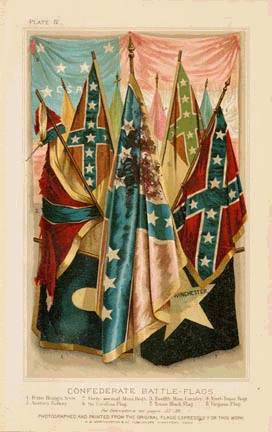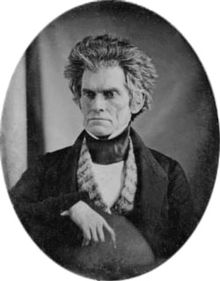With talk of secession heating up, a look back on the causes of America’s (first?) Civil War.
 As I type, the secession movement in California is picking up steam. Polling shows that one in three Californians support leaving the Union following Donald Trump’s victorious presidential campaign, and an organization–YesCalifornia.org–is circulating a petition calling for a special election that would allow Californians to vote for or against independence.
As I type, the secession movement in California is picking up steam. Polling shows that one in three Californians support leaving the Union following Donald Trump’s victorious presidential campaign, and an organization–YesCalifornia.org–is circulating a petition calling for a special election that would allow Californians to vote for or against independence.
The movement is unlikely to succeed, at least for now. Still, the secession question would seem to present an opportunity to look back on causes and conditions that led to America’s Civil War.
Obviously, it’s difficult to separate slavery from any discussion on the Civil War. The peculiar institution hovers over the conflict specter-like. Indeed, it’s an apparition that still haunts modern American politics. But to say that slavery was the sole cause of the Civil War overlooks other stark differences that divided the North and South in the lead-up to it. Historians have speculated that even had the slavery question been resolved peacefully, war or secession still might have occurred during the westward expansion.
Below are five other causes of the Civil War. To be fair, each of these causes was impacted by the institution of slavery to one degree or another. But each cause also existed apart from the institution of slavery.
1. Sweeping Economic Changes
Southern political insecurity was exacerbated by external economic pressure. Around the globe, more and more countries were ramping up production of raw cotton. While Southerners boasted that “Cotton is King,” their primary export had become steadily less valuable in the decade leading up to the Civil War. Since the South had no financial system to speak of, one bad crop often sent plantation owners to Yankee banks (or London ones). “In effect, the South had all the disadvantages of a one-crop economy,” wrote the historian Paul Johnson. The North, on the other hand, was a burgeoning industrial economy with an elaborate financial sector intent on expansion.
2. The Union Was Rapidly Changing Amidst Political Upheaval
In the decade preceding the conflict, California, Minnesota, Oregon and Kansas all became states. Up until the 1850s, the Union had survived largely through the Missouri Compromise, a Faustian bargain that maintained the political balance between the North and South but did nothing to address the slavery question. The question of how these states were admitted to the Union, and which ones, created tension between the North and South.

John C. Calhoun
It’s easy to lose sight of all the things that happened in the latter half of the 1850s. The Missouri Compromise was killed. The law that replaced it—the Kansas-Nebraska Act—was found unconstitutional (a stunning action at the time). A major political party (the Whigs) abruptly died. Two free states joined the Union (Oregon and Minnesota), while a slave state (Kansas) was initially denied entry. All of these things occurred under Democratic presidents relatively sympathetic to slavery. The prospect of a president opposed to slavery struck fear in the hearts of Southerners. As the nation changed, it seemed to give credence to John C. Calhoun’s warning (made just days before he died) that if the South waited too long to act it would no longer be strong enough to leave the Union (peaceably or not).
3. There Was a Breakdown of Decorum and Civil Discourse
Both North and South burned with righteous anger because both passionately believed in the justice of their cause. This caused not just harsh language, but spasms of violence that racked the nation. One of the earliest instances involved Elijah P. Lovejoy, a printer who was killed in 1837 when his small abolitionist newspaper was attacked by a mob of slave sympathizers. One of the last was John Brown’s deadly failed raid on Harpers Ferry in 1859.
 In between these events were numerous other violent events, and lawmakers were not immune. Perhaps the most notorious instance was Congressman Preston Brooks’ attack on Sen. Charles Sumner, who on the Senate floor delivered a speech filled with sexual innuendo that impugned the honor of a kinsman of the South Carolina Congressman. In response, Brooks attacked Sumner in his Senate office with a cane, leaving Sumner in a bleeding heap surrounded by cane shards. (It took two years for Sumner to recover.)
In between these events were numerous other violent events, and lawmakers were not immune. Perhaps the most notorious instance was Congressman Preston Brooks’ attack on Sen. Charles Sumner, who on the Senate floor delivered a speech filled with sexual innuendo that impugned the honor of a kinsman of the South Carolina Congressman. In response, Brooks attacked Sumner in his Senate office with a cane, leaving Sumner in a bleeding heap surrounded by cane shards. (It took two years for Sumner to recover.)
In normal times a violent attack on an old, unarmed man would spark outrage. Instead, as historian Shelby Foote noted, “Southern sympathizers sent Brooks walking sticks by the dozen, recommending their use on other abolitionists…” Brooks, censured by Congress, was later overwhelmingly reelected to his congressional seat.
4. Fundamental Disagreement on Constitutional Principles
Uncertainty as to what the federal government could and could not do began before the ink on the U.S. Constitution was dry. If, how, and to what extent the federal government could limit or abolish slavery loomed over American history.
Lincoln – both before and during the Civil War – said the federal government lacked the power to force emancipation on the states. The Founders had created a system “conceived in liberty” – but one, he admitted, that lacked the power to liberate the enslaved. Radical Republicans disagreed. All constitutional issues aside, the radicals probably were correct that no nation conceived on such lofty principles could indefinitely condone a system that enslaved.
Even before the Constitution was written, Samuel Johnson ironically asked, “How is it that the loudest yelps for liberty come from the drivers of Negroes?” By the 1850s the hypocrisy could no longer be ignored because of the sheer scope of slavery. The Census of 1860 shows there were some 4 million slaves in the South—compared to 78,000 in 1727 and 697,000 in 1790.
The South might have had the Constitution on its side, but history was not. Radical Republicans with increasing frequency came to believe they had a moral duty to abolish slavery, that they were obligated by “a Higher Law than the Constitution.”
5. Different Nations, Different Dreams
The North and the South shared a common history, but they effectively became two nations in the early 19th century. One was an agrarian society reliant on slave labor that exported cash crops; it had little liquid capital, less manufacturing, was debt-dependent, favored low tariffs, and opposed direct taxation. The other was an industrial economy that favored high tariffs (to protect industry), favored direct taxation, had an elaborate financial system, and was eager to expand into the West through homesteading and railroads.
The anti-slavery movement, many in the South believed, was merely a vehicle to achieve Northern dominance. Jefferson Davis, in a speech in the early 1850s, spoke for many Southerners when he said,
 “You free-soil agitators are not interested in slavery….not at all…
“You free-soil agitators are not interested in slavery….not at all…
It is so that you may have an opportunity of cheating us that you want to limit slave territory. You desire to weaken the political power of the Southern states. And why? Because you want, by an unjust system of legislation, to promote the industry of the North-East states, at the expense of the people of the South and their industry.”
So, to recap: In the lead-up to Civil War you had a rapidly changing economy precipitated by a suddenly expanding global marketplace, political upheaval in a period of national growth, sharp disagreement on the fundamental purpose and power of the federal government, a collapse of civil discourse and spasms of righteous violence, and a divided people with divergent dreams essentially attempting to build a nation in their own image built on their own ideals.
Sound familiar?
Written by Jon Miltimore and published by Intellectual Takeout ~ February 8, 2017.
Jon Miltimore is senior editor of Intellectual Takeout.
 FAIR USE NOTICE: This site contains copyrighted material the use of which has not always been specifically authorized by the copyright owner. We are making such material available in our efforts to advance understanding of environmental, political, human rights, economic, democracy, scientific, and social justice issues, etc. We believe this constitutes a ‘fair use’ of any such copyrighted material as provided for in section 107 of the US Copyright Law. In accordance with Title 17 U. S. C. Section 107, the material on this site is distributed without profit to those who have expressed a prior interest in receiving the included information for research and educational purposes. For more information go to: http://www.law.cornell.edu/uscode/17/107.shtml
FAIR USE NOTICE: This site contains copyrighted material the use of which has not always been specifically authorized by the copyright owner. We are making such material available in our efforts to advance understanding of environmental, political, human rights, economic, democracy, scientific, and social justice issues, etc. We believe this constitutes a ‘fair use’ of any such copyrighted material as provided for in section 107 of the US Copyright Law. In accordance with Title 17 U. S. C. Section 107, the material on this site is distributed without profit to those who have expressed a prior interest in receiving the included information for research and educational purposes. For more information go to: http://www.law.cornell.edu/uscode/17/107.shtml

